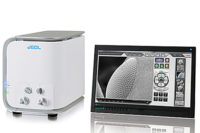
The HPX-1 CR system elevates the use of digital technology in what has traditionally been a film-based industry. Source: Carestream Health
Founded in 1987, Quality Inspection Services Inc. (QISI, Buffalo, NY) is a nondestructive testing firm with 17 locations in the United States. Working with both large and small companies, QISI specializes in nondestructive testing, quality assurance, quality control and civil testing.
Designated as the initial beta testing site for the Kodak Industrex HPX-1 CR system, QISI conducts more than 300 computed radiography projects per year for a wide array of clients that includes refineries, chemical plants, utility plants, the military and new fabrication products.
“Carestream/Kodak has specifically addressed the NDT industry’s unique field needs,” says Brian Caccamise, director of digital technology, QISI.
According to Caccamise, the HPX-1 CR system makes a significant leap in technology by elevating the use of digital systems in what has traditionally been a film-based industry.
“The information displayed on this new system is literally tenfold to that compared to conventional radiographic film,” says Caccamise. “As an inspection company, our code quality inspections require us to look at pipes to analyze welds. We perform a lot of radiographic profiling where we are looking at industry-specific concerns like corrosion under insulation (CUI), flow-accelerated corrosion (FAC), internal deposits and under-deposit corrosion. With the development of this system I can see that as an industry we are definitely trending upward toward digital.”
New System for NDT
“There are three important expectations we have for our CR systems,” says Caccamise. “The system has to fit the needs of our customers by performing in the field with accuracy and consistency; the system needs to be durable; and, finally, it needs to be user friendly for both the technician and the client.”Initial beta testing has proved that the system meets all three of these field requirements. At first glance, operators will note that the HPX-1 CR system has different physical characteristics compared to the Kodak Industrex ACR 2000 and 2000i.
“It’s great to see that they’ve redesigned the system with user expectations in mind,” says Caccamise. “The transport system is very smooth now; it allows the plates to go in and come out in a more efficient manner. It’s clearly a more rugged design with a positive air flow system, which will aid in prevention of dirt and damage to the plates.”

The new design requires less maintenance than past models, maintenance that can be easily handled by an organization’s own field technicians. Source: Carestream Health
Higher Quality Images
QISI tested the HPX-1 CR system against set standards that included known defects. The system passed all of the initial comparison tests and ended up exceeding staff expectations.“In our business we work primarily with flexible plates, but the system also accepts rigid cassettes. We tested all of the standard size plates and we were happy with the results,” adds Caccamise.
Tested plates include the following sizes, in both high resolution (HR) and general purpose (GP):
Software Improvements
“They have added some software features in the HPX-1 CR system that allow us to do image enhancements to aid in image interpretations,” continues Caccamise. “The software is very user-friendly as well. We can pull up multiple image views and work with these images simultaneously or independently. The new system also allows us to adjust the PMT [photo multiplier tube] and the laser to improve both gain and pixel resolution.”Product Benefits
After using the Kodak Industrex HPX-1 CR system for a week, QISI found that the CR system enables operators to work with larger size plates thanks to a more efficient transport system. The system accepts both rigid cassettes and flexible plates, and can work with multiple image views both simultaneously and independently. It offered additional software features to adjust PMT and laser strength to increase or decrease gain and pixel resolution. The design requires less maintenance, and maintenance can be easily handled by QISI’s own field technicians.Carestream Health’s NDT Solutions Group
(888) 777-2072
http://ndt.carestreamhealth.com
